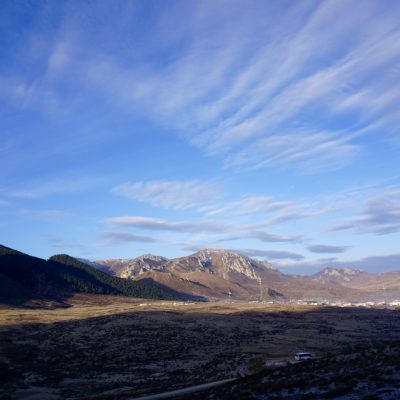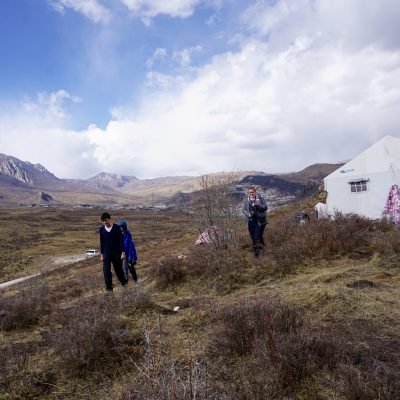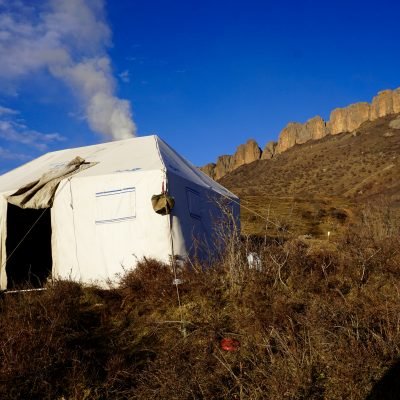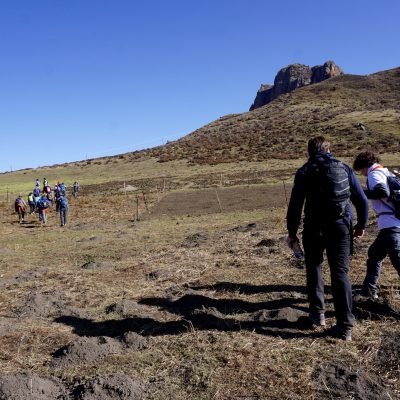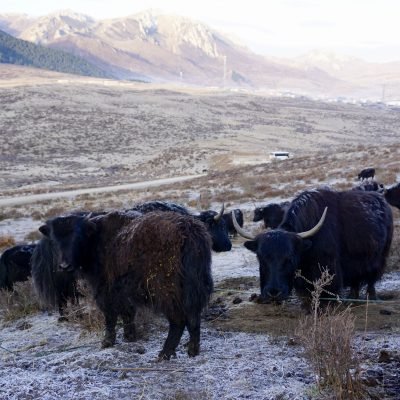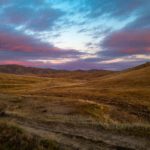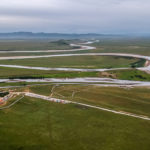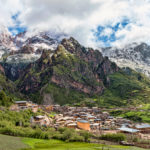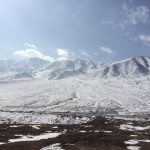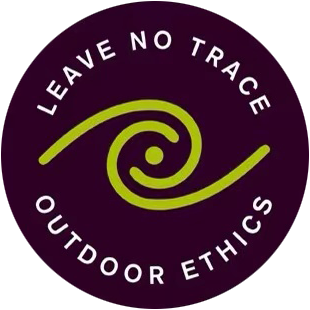Langmusi, at 3,345 meters in elevation, is a town that is known for it’s rich Buddhist culture and it’s amazing scenery, tucked away in the crags of 5000 meter mountains. It would be very easy to spend at least 2-3 days here in this quaint wonderland.
Kirti and Serti Monastery
The two main temples in Langmusi are the Kirti Monastery, located on the southern Sichuan side, and the Serti Monastery, located on the northern Gansu side of town. Serti is certainly the more lavish of the two monasteries as it receives some of its funding by the Chinese government, and the monastery in turn supports China’s appointed Buddhist spiritual leaders. Serti, the cleaner and more prestigious of the towns’ two monasteries, shines under the high altitude sun with brilliant golden roofs and is often undergoing major renovations and expansion upgrades.
Kirti Monastery, on the other hand, receives no funding from the government. Consequently, Kirti maintains an older, more organic feel as it’s temples are made wood, mud, aluminum, and cement. The roofs lack the loud colors and glam that adorn the Serti Monastery. Most of the Kirti side is comprised of the slightly tattered but humble living quarters of all the monks who reside there. But, while being a bit more toned down than neighboring Serti Monastery, I’ve found that most of the Tibetan pilgrims that walk and prostrate for months when traveling to Langmusi all go to Kirti, not Serti. In fact, most of the major gatherings of lamas and monks happen at Kirti despite its more rustic character.
Regardless of personality, both monasteries are certainly worth a visit and it is a fantastic experience to walk alongside the pilgrims who have come from 100’s of miles all around the grasslands to land and worship in Langmusi.
Hiking and Horse Trekking in Langmusi
Namo Gorge and Huagai god Mountain
Walking through Kirti Gompa and up the valley, you will reach the start of Namo Gorge. You have to pay 30Y at the entrance to the monastery, which gets you access to the monastery itself and the gorge, but it is possible to bypass this if you walk up the road to the right of the ticket office, up and over the hill and down to the start of the gorge.
Once past the ticket gate, there is a wide open field where you might happen to stumble upon young monks playing soccer or relaxing in the grass reading a book. This is the just outside the walls of the Kirti Monastery and as such is the “playground” for the 100’s of monks that reside there. Moving past this area as you follow the river upstream you quickly enter a narrow gorge. Just on the right of this gorge is a statue of a tiger wrapped in Cata scarves and is a small cave, known as a home to local mountain spirits. The cave is no bigger than a modest size apartment but there is a small hole in the backside of the cave where you may find that local Tibetan nomads are trying to wiggle in and out of. Legend has
Once you pass the cave, you will walk alongside the White Dragon River for about 10 minutes until you eventually come to the spring that the river emerges out of. From this point continue up the dirt trail another 20 minutes to another gorgeous open grass valley. This is about as far as most tourists get, so if you continue in the canyon to your right up the fork, you will virtually have the whole gorge to yourself. It is possible to walk for a considerable distance into the gorge and mountains beyond, being surrounded by amazing scenery and peace and quiet. Eventually the trail (if you keep just staying right ) will take you along the side of some brush and over the top of a tableland known as “Huagai god Mountain”. From this view among the sharp rocks of the peak at 4,200 meters you get an excellent view of both Langmusi town and the wide open grasslands.
The hiking in this gorge can be anywhere from 20 minutes to 8 hours. There is really enough here for any level of adventure seeker!
Red Rocks hike
Walking in the other direction from the village – towards the main road – one encounters an interesting sandstone formation or mesa whose top is accessible. To access this, just look up to the Red Rock formations immediately outside of town, and walk a street about 1km out into the open pastures at the bottom of the mountain. From here wind up through an old sheep trail to get on top of the red rock cliffs. The hike up from town is about 2-3 hours and the Prayer flags here on the top are around 3,700 meters. There is a great view looking back on the Gansu side of Langmusi town and this makes for a great half day hike and an excellent picnic ground.
Horse Trekking
One of the town’s must-do activities is the horse trekking. Langmusi offers anything from 1 to 3 day horse treks where you can stay with real Tibetan nomads in their tents. The guides on all their trips are professional and experienced. Liyi, the owner at the horse trekking place speaks excellent English and is a great resource for any questions or tips about Langmusi. They also do biking trips and bike rentals. You can go to the grasslands by yourself with the bike or organize an amazing two-day homestay bike trip directly through them. They also own the Black Tent Cafe across the street – which is highly recommended for a little coffee, cake, or for their smoothies.
Sky Burial
Please beware that the information below might be disturbing to some. A sky burial is where the deceased Buddhist is hauled up a mountain, adorned in prayer wrappings, and left to be taken by the birds. After the birds do most of the work, the body is chopped up and burned. For many Tibetans, a sky burial is an entirely natural and beautiful way to go (and is often considered as a last act of compassion in giving one’s body to nature). I tend to agree and would much rather have a sky burial than be put in some box in field of other boxes. That said, visiting a sky burial site not long after a burial is quite an experience.
If you walk up past the left side of Serti Monastery, you’ll eventually come to a clearing near a hilltop (ask any local around Serti and he or she can point you in the right direction). The clearing has two boxes of axes and knives, prayer flags, and a pile of ashes. Once the birds are basically done with the main job, the remains are burned. However, not everything makes it into the fire, which means the site is literally littered with skulls, hip bones, and other various bits and pieces. We’d come only days after a burial, so some of the bones even had flesh and skin still on them.
I know it sounds gross, but if you’re curious about this sort of thing, I’d say this is a must see, as chances to experience this sort of thing don’t come around too often.
Langmusi in General
Langmusi is a sleepy village in a remote breathtaking location predominantly inhabited by a colorful mix of Hui Muslims and Amdo Tibetans. It is said that the provincial borderline runs through the middle of town with Sertri Gompa in Gansu and Kirti Gompa located in Sichuan. The power struggles between the two Gompa may have been the reason for the border location. Both temples have distinct styles making both well worth the visit alone. The surrounding mountains give off a very much alpine flair reminiscent of rural Austria or Bavaria and perfect for hiking and horse trekking.
While there are continually construction projects in all seasons (as in virtually every Chinese town, down to the tiniest backwater), much of the money that tourists bring in appears to be going to renovating and improving Tibetan temples and meeting places, or into local businesses catering to the seeker of Tibetan culture.
At this point [October 2015], the village has developed a budget-friendly backpacker vibe, not unlike Shaaxi village in Yunnan province. Yet, even in high season [the height of the October holiday, and after the swarming hordes of Jiuzhaigou], tourists are relatively few, and this is very much an active religious community with many monks and initiates to be seen walking the roads and playing behind the major monastery. The monks and students are not shy, happy to have a chat in Chinese and to a lesser extent English, and deeply appreciative of even the most basic Tibetan greetings (‘tashi delek’ means “Hello”). The majority of the visitors to this town are Han Chinese, and few if any make the effort to learn any Tibetan phrases.
Getting there
There is only one bus every day from Xiahe direct to Langmusi leaving at around 7:40 a.m. (Dec 2014) from the Xiahe Bus Station. 72Y.
If you miss this bus, or if you can’t get tickets, you can take any early morning bus to Hezuo (1 hour from Xiahe) and then take one of the Hezuo(合作)buses to Langmusi. There are a couple buses from Hezuo to Langmusi each day. There definitely is one leaving at 10:20AM.
When you get to Hezuo, you will need to take a taxi across town to the South Bus Station (Nan Zhan – 南站) where the buses leave for Langmusi.
If you were thinking of hiring a car to take you directly from Xiahe to Langmusi, be ready to pay a lot of money. It will cost you at least ¥350 to hire a car for the trip. The bus is only ¥ 71 per person. If you do end up taking a taxi, be sure to ask to take the “scenic route.” The road is a little bumpier than the new highway, and a takes a little longer, but you pass beautiful grasslands, mountains, and tibetan villages along the way.
There are also direct buses to Zoige (Ruo’ergai) in northern Sichuan. There is currently no direct bus to Songpan but the situation may change, as a new highway was completed in 2007.
You can also catch a bus in Jiuzhaigou to Langmusi. There are multiple buses leaving every morning between 7am and 8am. The bus will let you off on the main road outside of Langmusi, not actually driving into town, leaving you with a 1+ km walk, or there will be cars around to get you into town (for a few yuan).
To get out of town up towards Xiahe, there is only one afternoon direct bus a day. You can get morning buses to Hezuo, then a cab to the West Bus Station, then catch a bus to Xiahe. There are many buses to Xiahe each day.
